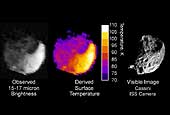|
COMETS EARTH JUPITER KUIPER BELT MARS MERCURY METEORITES NEPTUNE OORT CLOUD PLUTO SATURN SOLAR SYSTEM SPACE SUN URANUS VENUS ORDER PRINTS
PHOTO CATEGORIES SCIENCEVIEWS AMERICAN INDIAN AMPHIBIANS BIRDS BUGS FINE ART FOSSILS THE ISLANDS HISTORICAL PHOTOS MAMMALS OTHER PARKS PLANTS RELIGIOUS REPTILES SCIENCEVIEWS PRINTS
|
Related Documents
Download Options
This image shows thermal radiation from the day and night sides of Saturn's moon Phoebe, taken by the composite infrared spectrometer onboard Cassini 1.8 hours before the spacecraft's closest approach to Phoebe on June 11, 2004. The left-hand panel displays the image in grayscale format, showing the brightness of Phoebe's radiation in the wavelength range 15-17 microns, which is about 25 times the longest wavelength visible to the naked eye. In the middle panel this brightness is used to estimate the surface temperature distribution across Phoebe. Temperatures are given in degrees Kelvin, and vary from a relatively toasty 107 Kelvin (-267 Fahrenheit), in the late morning near the equator (white, lower right), to less than 75 Kelvin (-324 Fahrenheit) in the northern hemisphere in the pre-dawn hours (dark blue, upper left). The "ragged edge" of Phoebe in this region is an instrumental artifact. Temperatures are affected strongly by topography, as can be seen by comparison with the visible-wavelength image (right). Some of the coldest temperatures are found in the shadowed region inside the large depression in the northern hemisphere (upper right). |
